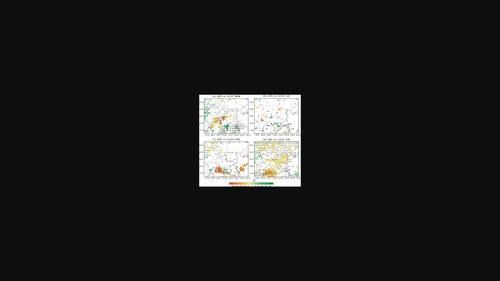当前位置:
X-MOL 学术
›
Int. J. Climatol.
›
论文详情
Our official English website, www.x-mol.net, welcomes your
feedback! (Note: you will need to create a separate account there.)
Investigating the relative contribution of anthropogenic increase in greenhouse gas and land use and land cover change to Asian climate: A dynamical downscaling study
International Journal of Climatology ( IF 3.5 ) Pub Date : 2022-09-06 , DOI: 10.1002/joc.7854 Weiyue Zhang 1, 2 , Zhongfeng Xu 2 , Weidong Guo 3
International Journal of Climatology ( IF 3.5 ) Pub Date : 2022-09-06 , DOI: 10.1002/joc.7854 Weiyue Zhang 1, 2 , Zhongfeng Xu 2 , Weidong Guo 3
Affiliation

|
Human activity have caused significant increase in greenhouse gas (GHG) concentration and land use and land cover change (LULCC), which can in turn affect regional and global climate. We investigate the relative contributions of increased GHG concentration and LULCC to the precipitation and surface air temperature (SAT) in Asia through three dynamical downscaling simulations with different land cover maps and GHG concentrations. The results suggest that the increased GHG concentration leads to an increase (decrease) in precipitation over East Asia and Southeast Asia (South Asia) in spring and winter. Over Southeast Asia and the Bay of Bengal, LULCC induced a significant decrease in precipitation in autumn and winter, and the change is greater than that induced by GHG. Moreover, the enhanced GHG concentration generally leads to a decrease in dry days or light rain days and an increase in heavy rain days over the land area. However, LULCC-induced changes in extreme precipitation are generally weak. The increased GHG concentration induces a significant increase of 1–3°C in the SAT throughout the year. LULCC plays a more important role than the increased GHG concentration in modulating the SAT over South Asia, Southeast Asia, and East Asia throughout the year. The increased GHG concentration and LULCC cause a broader range of changes in the daily temperature frequency. The anomalous warm event of 8–10°C increases by 1–1.5 days per season in the middle latitude regions in boreal spring due to the increased GHG concentration. LULCC also leads to an increase in high-temperature events except central Asia.
中文翻译:

调查人为增加温室气体和土地利用以及土地覆盖变化对亚洲气候的相对贡献:动态降尺度研究
人类活动导致温室气体 (GHG) 浓度以及土地利用和土地覆盖变化 (LULCC) 显着增加,进而影响区域和全球气候。我们通过使用不同土地覆盖图和 GHG 浓度的三种动态降尺度模拟,研究了增加的 GHG 浓度和 LULCC 对亚洲降水和地表气温 (SAT) 的相对贡献。结果表明,温室气体浓度增加导致春季和冬季东亚和东南亚(南亚)降水增加(减少)。在东南亚和孟加拉湾,LULCC 导致秋冬季节降水显着减少,且变化幅度大于 GHG。而且,温室气体浓度的增加通常会导致旱天数或小雨天数减少,而大雨天数增加。然而,LULCC 引起的极端降水变化普遍较弱。增加的温室气体浓度导致全年 SAT 显着增加 1-3°C。LULCC对南亚、东南亚和东亚全年SAT的调节作用比GHG浓度增加更为重要。增加的 GHG 浓度和 LULCC 导致日温度频率的变化范围更广。由于温室气体浓度增加,北半球春季中纬度地区8~10℃的异常增暖事件每季增加1~1.5天。LULCC 还导致除中亚以外的高温事件增多。
更新日期:2022-09-06
中文翻译:

调查人为增加温室气体和土地利用以及土地覆盖变化对亚洲气候的相对贡献:动态降尺度研究
人类活动导致温室气体 (GHG) 浓度以及土地利用和土地覆盖变化 (LULCC) 显着增加,进而影响区域和全球气候。我们通过使用不同土地覆盖图和 GHG 浓度的三种动态降尺度模拟,研究了增加的 GHG 浓度和 LULCC 对亚洲降水和地表气温 (SAT) 的相对贡献。结果表明,温室气体浓度增加导致春季和冬季东亚和东南亚(南亚)降水增加(减少)。在东南亚和孟加拉湾,LULCC 导致秋冬季节降水显着减少,且变化幅度大于 GHG。而且,温室气体浓度的增加通常会导致旱天数或小雨天数减少,而大雨天数增加。然而,LULCC 引起的极端降水变化普遍较弱。增加的温室气体浓度导致全年 SAT 显着增加 1-3°C。LULCC对南亚、东南亚和东亚全年SAT的调节作用比GHG浓度增加更为重要。增加的 GHG 浓度和 LULCC 导致日温度频率的变化范围更广。由于温室气体浓度增加,北半球春季中纬度地区8~10℃的异常增暖事件每季增加1~1.5天。LULCC 还导致除中亚以外的高温事件增多。











































 京公网安备 11010802027423号
京公网安备 11010802027423号